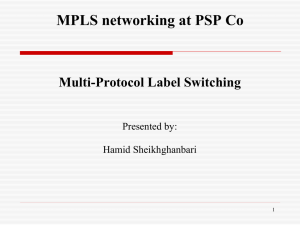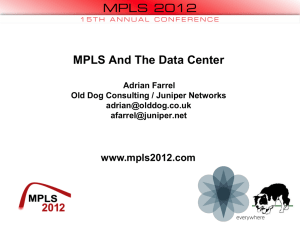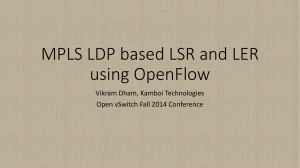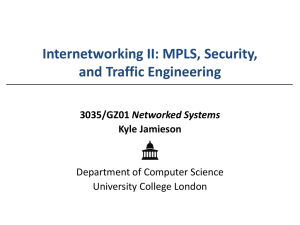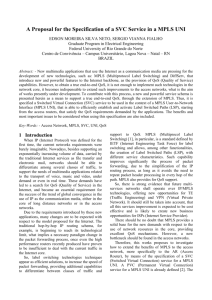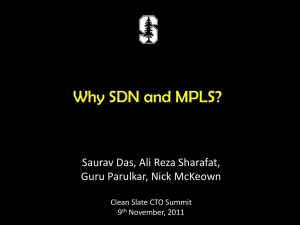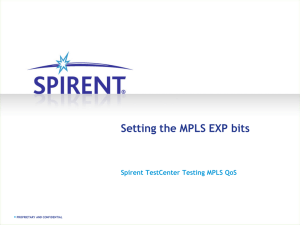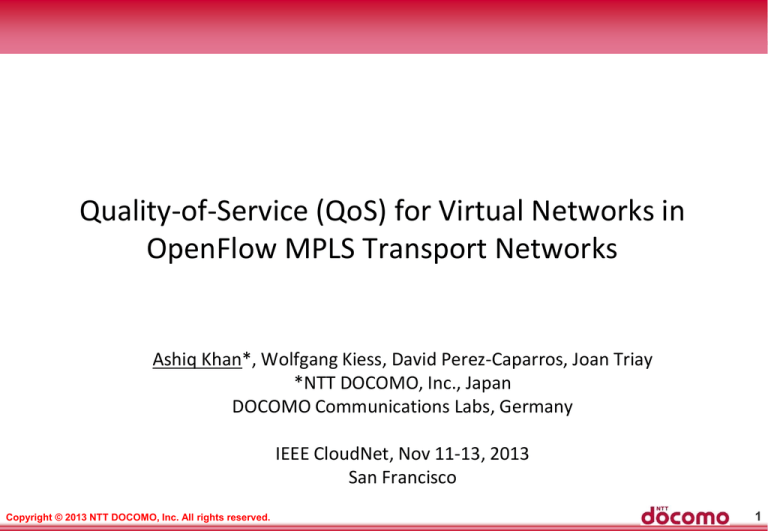
Quality-of-Service (QoS) for Virtual Networks in
OpenFlow MPLS Transport Networks
Ashiq Khan*, Wolfgang Kiess, David Perez-Caparros, Joan Triay
*NTT DOCOMO, Inc., Japan
DOCOMO Communications Labs, Germany
IEEE CloudNet, Nov 11-13, 2013
San Francisco
Copyright © 2013 NTT DOCOMO, Inc. All rights reserved.
1
Contents
Background and Objective
QoS in MPLS: an overview
Proposal
Evaluation: prototype
Conclusions
Copyright © 2013 NTT DOCOMO, Inc. All rights reserved.
2
Background
OpenFlow virtualizes/slices transport networks easily
Lacks scalability, QoS support
MPLS is scalable, has carrier-grade QoS support
Lacks virtualization capability when it comes to QoS
Cloud/Datacenter
OpenFlow
OpenFlow
OpenFlow
Cloud/Datacenter
Cloud/Datacenter
MPLS transport domain
Impractical to replace all MPLS switches in one day…. but then,
How to accommodate multiple virtual networks with QoS guarantee
Copyright © 2013 NTT DOCOMO, Inc. All rights reserved.
3
Objective
Accommodate multiple virtual networks in MPLS domain
MPLS can isolate multiple QoS classes
but, multiple VNs mean isolating now within a QoS class
5G
4G
Video (QoS-1)
5G
4G
MPLS switch
Voice (QoS-0)
MPLS switch
How can we realize this without changing MPLS implementations
Copyright © 2013 NTT DOCOMO, Inc. All rights reserved.
4
MPLS QoS support
overview
MPLS defines two bandwidth constraint models
Maximum Allocation Model (MAM)
Strict BW isolation among classes
Russian doll Model (RDM)
Aggregated BW to a set of classes
C2
C1
Maximum
Reservable
Bandwidth
C2
+
C1
C1 +
+ C0
C0
C0
Maximum
Reservable
Bandwidth
C0
a. MAM
Unused BW are wasted
b. RDM
Complex management and preemption task
Both classes need to be addressed for multiple VN accommodation
Copyright © 2013 NTT DOCOMO, Inc. All rights reserved.
5
Creating multiple virtual networks ….
principle
Without any special support from MPLS
Transparent to MPLS
VN-0
VN-1
C2
Maximum
Reservable
Bandwidth
C1
+
C0 C0
C1
C0
a. MAM
C1
+
C0 C0
C2
+
C1
+
C0
Maximum
Reservable
Bandwidth
C2
+
C1
+
C0
C2
+
C1
+
C0
C1
+
C0
C0
b. RDM
Need a flexible, programmable admission control mechanism
Copyright © 2013 NTT DOCOMO, Inc. All rights reserved.
6
Proposed architecture
OpenFlow (OF) as the Admission Controller to the MPLS domain
Info from MPLS domain
QoS MPLS
MPLS
class Max BW Available BW
Per VN reservation state
VN
VN-0
VN-1
QoS class Max BW Available BW
C0
C1
C0
C1
6
7
4
8
0
4
3
+
6
C0
C1
10
15
Session Establishment Request
Session data transfer
3
VN-0
VN-1
10
Source/Destination
OpenFlow Controller
LSR
LSR
MPLS switching domain
LER
OpenFlow switch
OpenFlow Domain A
Source/Destination
OF Domain B
LER: Label Edge Router
LSR: Label Switching Router
Source/Destination
LER
Source/Destination
LSR
Source/Destination
The whole process remains transparent to the MPLS domain
Copyright © 2013 NTT DOCOMO, Inc. All rights reserved.
7
Experiment platform
prototyping
Topology
OpenFlow Controller
(Floodlight)
Host A
Host B
MPLS LER 1
Host C
MPLS QoS BW per QoS
C0
40%
MPLS LSR
OpenFlow Switch
(Open vSwitch)
MPLS LER 3
C1
60%
Virtual Network
VN1
VN2
VN1
VN2
BW per VN
20%
20%
20%
40%
Host D
MPLS LER 2
VN1: Host A, Host B
Bandwidth allocation in the MPLS domain
VN2: Host C, Host D
Configuration
All hosts are virtual machines (Ubuntu 12.04, VMWare, HP blade center 520)
MPLS switches: MPLS kernel extension* on Debian 4
Links bandwidth: 6.3 Mbps
*MPLS Linux Labs by Sourceforge
Copyright © 2013 NTT DOCOMO, Inc. All rights reserved.
8
Results
MAM
Achieving isolation and appropriate admission control
Bandwidth allocation in the MPLS domain
BW
Time
t1
t2
t3
t4
Session
VN1-C1
VN2-C1
VN1-C0
VN2-C0
Scenario 1
30%
40%
20%
20%
Scenario 2
20%
60%
20%
20%
MPLS QoS BW per QoS
C0
40%
C1
60%
Virtual Network
VN1
VN2
VN1
VN2
BW per VN
20%
20%
20%
40%
(b) with OF admission control
(a) without OF admission control
Fig: Accommodation of multiple VNs in MAM model
Isolation achieved without any modification in the MPLS domain
Copyright © 2013 NTT DOCOMO, Inc. All rights reserved.
9
Results
RDM -1
Achieving isolation, appropriate admission control and preemption
Bandwidth allocation in the MPLS domain
BW
Time
t1
t2
t3
t4
Session
VN1-C1
VN2-C1
VN1-C0
VN2-C0
Scenario 1
30%
40%
20%
20%
(a) without OF admission control
Scenario 2
20%
60%
20%
20%
MPLS QoS BW per QoS
C0
40%
C1
60%
Virtual Network
VN1
VN2
VN1
VN2
BW per VN
20%
20%
20%
40%
(b) with OF admission control
Fig: Accommodation of multiple VNs and consequent operations in RDM model for Scenario 1
Intra-VN preemption is also possible without any modification in MPLS
Copyright © 2013 NTT DOCOMO, Inc. All rights reserved.
10
Results
RDM -2
Achieving isolation, appropriate admission control and preemption
Bandwidth allocation in the MPLS domain
BW
Time
t1
t2
t3
t4
Session
VN1-C1
VN2-C1
VN1-C0
VN2-C0
Scenario 1
30%
40%
20%
20%
(a) without OF admission control
Scenario 2
20%
60%
20%
20%
MPLS QoS BW per QoS
C0
40%
C1
60%
Virtual Network
VN1
VN2
VN1
VN2
BW per VN
20%
20%
20%
40%
(b) with OF admission control
Fig: Accommodation of multiple VNs and consequent operations in RDM model for Scenario 2
Intra-VN preemption is also possible without any modification in MPLS
Copyright © 2013 NTT DOCOMO, Inc. All rights reserved.
11
Conclusions
Summary
Proposed method for accommodating multiple virtual networks in
MPLS
Proposed method doesn’t require any change in the MPLS domain
Verified the proposal by elementary prototype
Future Works
QoS in the OpenFlow domain
Large scale experiment
Isolation guarantee at the MPLS core
Copyright © 2013 NTT DOCOMO, Inc. All rights reserved.
12
Ashiq Khan
khan@nttdocomo.co.jp

